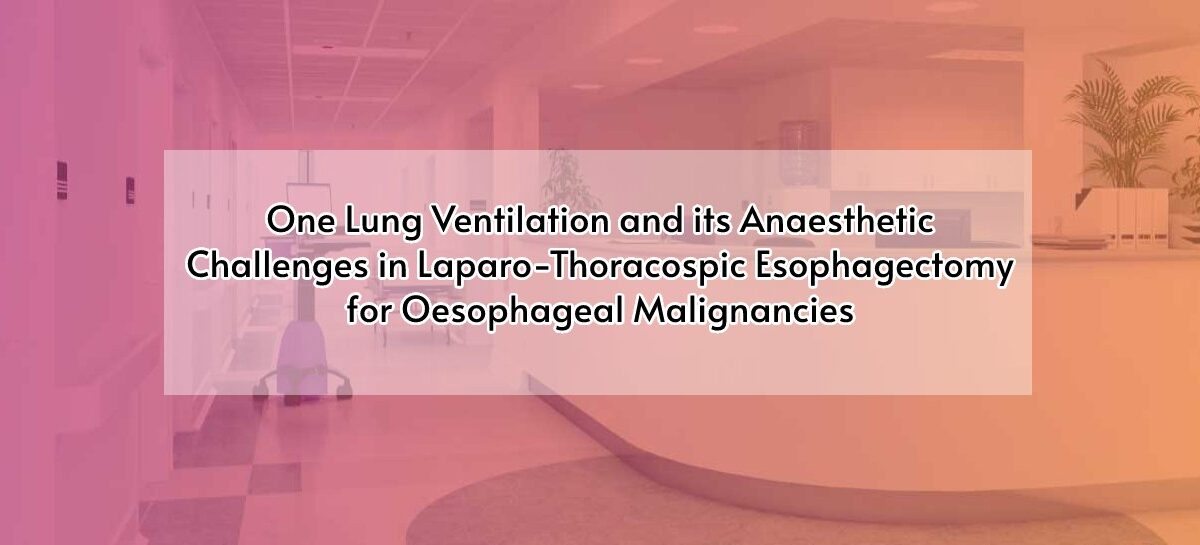Introduction
The anaesthesiologist has an important role in the multidisciplinary management approach to oesophageal malignancies. Anaesthetists provide good perioperative care by means of a reduction in pain and stress, and ventilation and fluid management strategies in these high-risk oesophageal surgeries. These malignancies require complex minimally invasive surgical and anaesthetic techniques to reduce morbidity and mortality during the perioperative period. Minimally invasive oesophageal cancer resection needs one lung ventilation anaesthesia. One lung ventilation(OLV) is always a technically challenging procedure even in experienced hands, especially in laparo-thoracospic esophagectomy. This article deals with the common physiological, technical and other perioperative anaesthetic challenges that occur in one lung ventilation in relation to thoracospic esophagectomies.
Discussion
Structured preoperative care is an initial mandatory step to proceed with these types of complex surgeries. Because most patients with oesophageal malignancies have a poor nutritional status, one or more comorbidities may exist and neoadjuvant chemotherapy may be required. These issues should be optimized by a multidisciplinary team approach before proceeding with the complex surgery. If we plan athoracospic approach with OLV, the patient’s cardiopulmonary functional evaluation needs to be optimized for a better post-operative outcome. Most of the patients are smokers, which directly aggravates the adverse event of OLV related complications like hypoxemia, ALI and ARDS in the perioperative period. Chemoradiation and smoking both have an adverse effect on cardiac function, which directly influences the morbidity related to OLV. Hence in preoperative evaluation along with other systemic approaches, it is mandatory to optimize the cardiac and lung functions.
One lung ventilation is used to facilitate a wide variety of procedures like lung isolation and exposure of ipsilateral thoracospic/mediastinal procedures.
Initiation of OLV
One lung ventilation is initiated by the use of double lumen tubes (DLTs), bronchial blockers, and endobronchial tubes. The most common and familiar technique is the insertion of a double lumen tube. First of all, the intubation of a double lumen tube needs familiarity and special skills. Once intubation is successfully carried out, the anaesthesiologist’s knowledge of tracheal anatomy helps to identify the correct positioning of the tube and also in selectively isolating one lung for ventilation. The exact placement of DLT is facilitated by using a fibreoptic scope after intubation. In this technique, one of the lumens in the DLT tube is free to ventilate one lung and the other lumen is clamped to let the other lung collapse for surgical exposure of the thoracic and mediastinal structures. Hence, the placement of double lumen tube in the correct position, which is ensured by bronchoscopy, is mandatory for hassle free surgical access.
Physiological changes during OLV
After successful placement of the DLT, we can initiate single lung ventilation by either clamping the tracheal or bronchial lumen. Single lung ventilation aims at two separate goals – to maintain adequate oxygenation and to maintain lung isolation and lung protection. During single lung ventilation, the ventilation to one of the lungs is interrupted, which produces atelectasis that leads to hypoxia; but the perfusion is still present in the non-ventilated lung, which leads to an intrapulmonary shunt. This shunt produces hypoxemia and hypercarbia. Ventilation and perfusion (V- Q) matching plays a significant role in the management of oxygenation in patients on single lung ventilation. Usually, during OLV a higher-than-normal level of carbon dioxide is allowed, known as ‘permissive hypercapnia’. Hypoxemia is inevitable and can be allowed up to 90%. These two are the biggest challenges to the anaesthesiologist during OLV.
Laparo – thoracoscopic esophagectomy is a special situation for one lung ventilation, because here the oesophageal mobilization is done in a prone position. In OLV, the prone position is rare due to the increased risk of more hypoxia. Due to gravitational force, the nonventilated lung will receive more blood supply than the ventilated lung which increases the V-Q mismatch. When OLV is considered, this position is comparable to the supine position, where the area of atelectasis is also high. The atelectasis is more difficult to manage in the prone position than the supine in OLV. Therefore, during thoracoscopic oesophageal mobilization, these known challenges of OLV are more aggravated in the prone position.
Another well-known protective mechanism to control hypoxia is that of hypoxic pulmonary vasoconstriction (HPV), which can counteract hypoxia to a certain degree. This protective mechanism is active when the alveolar pAo2 is between 40–100 mmHg in the adult and also with the percentage of the hypoxic area of the lung being 30-70%.This HPV is a biphasic temporal phenomenon, that occurs in seconds, and will reach a plateau within 15 minutes and last for 4 hours. HPV along with the mechanical collapse of the lung reduces the shunt flow through the operative lung by roughly 40%, thus facilitating the safe conduct of OLV. HPV is inhibited to some extent by vasodilators, including all anaesthetic gases(more than1%) and induction agents.
Next is the incidence of ARDS and Acute Lung Injury(ALI) associated with OLV in esophagectomies. This occurrence in the perioperative period is reported as 16-30%. Factors like alveolar inflammatory mediator production and cellular infiltrates are responsible for this inflammatory lung damage. This mediator release is attributed to fluid overload, vascular leakage, damage of lung lymphatics and pulmonary endothelial damage. In one lung ventilation, all these factors together contribute to postoperative pulmonary morbidity.
The above set of factors and adverse incidences will be overcome by the effective preop patient selection and optimization. Effective ventilation strategies like minimal tidal volume(5-7ml/kg) ventilation, application of effective PEEP, maintaining optimal peak inspiratory pressure(30-35cmH2O)are mandatory to avoid adverse perioperative events. Finally, effective fluid management is essential for perioperative lung productive strategy. By using pulse pressure and stroke volume variation, the goal directed fluid therapy (GDFT) is applied effectively to reduce the extravascular lung water (EVLW) in patients undergoing athoracospic procedure.
Conclusion
Minimally invasive Oesophageal surgeries are technically complex for both the surgeon and the anaesthetist. For a good perioperative outcome, the anaesthetist’s balanced approach during one lung ventilation is essential. In OLV, the maintenance of intraoperative pulmonary physiology and hemodynamic goals are challenging tasks for a skill ful anaesthesiologist. A good perioperative optimization strategy needs to be formed for a successful outcome.
References
- Slinger (ed.), Principles and Practice of Anesthesia for Thoracic Surgery, 71 DOI 10.1007/978-1-4419-0184-2_5, © Springer Science+Business Media, LLC 2011
- Single Lung Ventilation Mayank Mehrotra; Ankit Jain. Last Update: July 31, 2021.
- ONE-LUNG VENTILATION Dr Lesley Strachan Consultant Anaesthetist Aberdeen Royal Infirmary
- Hypoxaemia during one-lung anaesthesia Alexander Ng MB ChB DA(UK) FRCA MD Justiaan Swanevelder MB ChB FRCA FCA(SA) MMed
 Dr. Karthickraja, MD, DA, FIPM
Dr. Karthickraja, MD, DA, FIPM
Senior Consultant Anaesthesiologist and Pain Physician
Department of Anaesthesia and Pain Medicine
Kauvery Hospital, Chennai



